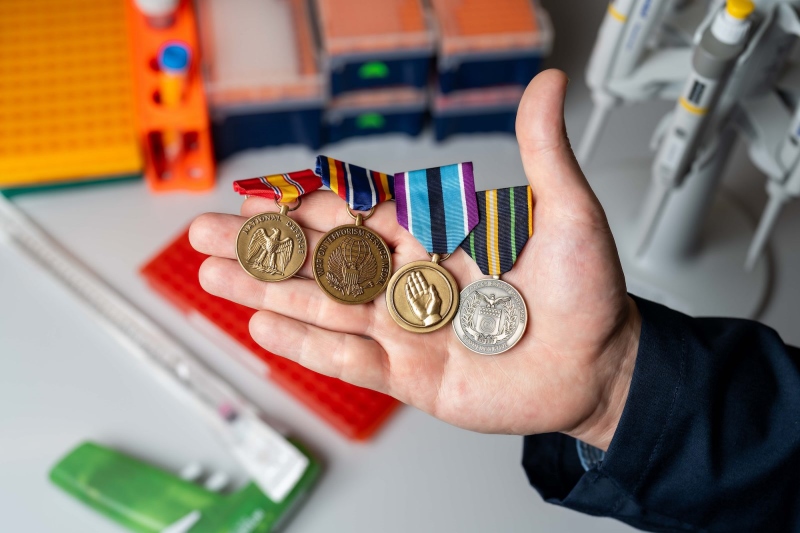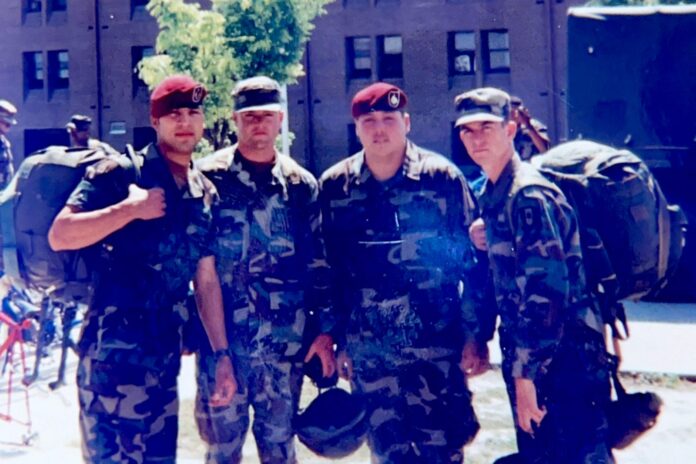The Army wanted Donato Rivas to drive a tank.
He wound up jumping out of planes instead. But Rivas’ time as a paratrooper and combat medic provided an unlikely spark for his future career as a scientist studying physiology, bioenergetics, and exercise medicine research.
Rivas recently joined the Fralin Biomedical Research Institute at VTC as a research associate professor. He aims to continue an investigation of muscle damage and healing that he began at the U.S. Army Research Institute of Environmental Medicine. As the Army strives to remain stronger with fewer troops, research that returns injured soldiers back to health and service sooner is vital. That research also could inform the treatment of other life-altering conditions.
“As a medic, I liked the feeling of helping people and seeing the real-world impact I had on patients,” said Rivas, a member of the research institute’s Center for Exercise Medicine Research. “The injuries I observed and treated increased my curiosity about why they happen, and how to aid in the prevention and recovery of injured soldiers.”
Combat medic
Growing up in Southern California, Rivas was a good enough student in high school. His Peruvian father had come to the United States for college and then returned later with his family to work for McDonnell Douglas. His father prized education, but Rivas wasn’t fired up about college.
“I always did well in science, but it didn’t drive my passion or anything like that,” he said.
He opted for the Army out of high school instead. After passing on driving tanks as an armor crewman, he chose to become a medic, following the course set by his mother, a nurse.
To train as a combat medic, he needed to join an airborne unit and acquire parachuting skills. During his active-duty service, his role largely involved providing support in response to natural disasters or civil unrest rather than direct combat.
 As a result, he didn’t see as many combat wounds as he did injuries – from paratroopers taking hard landings, for example, or even just from training. His airborne unit stressed fitness, and injuries from rigorous training were common.
As a result, he didn’t see as many combat wounds as he did injuries – from paratroopers taking hard landings, for example, or even just from training. His airborne unit stressed fitness, and injuries from rigorous training were common.
Rivas liked the work enough that when his service ended, he decided to go to college at California State University Northridge for sports medicine.
While in college, his professors encouraged Rivas to apply for an undergraduate fellowship with the National Institutes of Health. The Maximizing Access to Research Careers program promotes broader participation in the biomedical research workforce. “I was just like, ‘Oh, I’ll do it.’ They’d be paying for school,’” he said.
It changed the course of his life.
Where dissecting a frog in high school biology class felt like an isolated exercise, now he was studying human metabolism and exercise, and the connection of science to health sparked his passion. He dropped his sports medicine focus in favor of exercise physiology.
The fellowship led him to another fortuitous change, too. While working in the lab, he met a doctoral candidate who had come from a university in Australia to complete her dissertation research in his same lab. After graduating, he followed Sarah Lessard back to Australia, where he pursued his own doctorate. Ultimately, they married. Lessard joined the Fralin Biomedical Research Institute this year.
While in graduate school, he also met a groundbreaking exercise medicine researcher named Zhen Yan — the same scientist who now leads the research institute’s Center for Exercise Medicine Research.
Helping soldiers heal
Back in the United States, Rivas investigated sarcopenia, the progressive loss of muscle mass and strength, and how muscles become resistant to nutrition and exercise in older age, at the U.S. Department of Agriculture’s Human Nutrition Research Center on Aging. He moved on to become an assistant professor at the Friedman School of Nutrition at Tufts University.
And then he was back in the realm of the Army, as a research physiologist in the military performance division of the U.S. Army Research Institute of Environmental Medicine.
The Army wanted an expert to focus on muscle regeneration, particularly following injuries caused by trauma, routine training or more intense operations.
“That’s a big expense for the military, when a service member is not available for training or deployment” Rivas said. “That affects military readiness, as it’s essential to have enough personnel fit for both training and deployment. They wanted someone to explore ways to improve injury treatment and speed up recovery.”
The American military has struggled to meet recruiting goals in recent years, and the Army is at its smallest since World War II, according to Department of Defense data.
That makes it more important to keep service members healthy later into their careers so they remain ready for training and deployment.

Rivas’s research examines the potential uses of “prehabilitation” that preconditions a person’s muscles prior to an extraordinary event so they can resist injury or a decline in performance. Study participants are put through rigorous exercise to cause some light muscle damage to see if this ‘primes’ the muscles to respond better to a more damaging exercise later.
Rivas said over-inflammation of the muscle in response to an injury can actually destroy undamaged tissue and prevent regeneration and healing.
Learning how muscles heal fastest can potentially point to therapeutic approaches to keep soldiers ready for service.
Rivas likes how military research is practical and narrowly focused on a specific need, but he hopes to continue and expand that research at Virginia Tech and show its value for a range of conditions.
At the Army research institute, most study volunteers are young, male service members. He hopes to be able to draw a more diverse set of participants now and learn about differences in how muscles regenerate across sex and age differences.
What he learns could have value for treatment of the effects of aging, diabetes, and even cancer, Rivas said.
“Being here at Virginia Tech and the Fralin Biomedical Research Institute allows me to make my research even more broadly practical,” he said. “Including figuring out how the benefits of what we learn is going to actually get to people to help them in the end.”
By Matt Chittum

